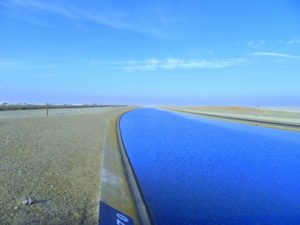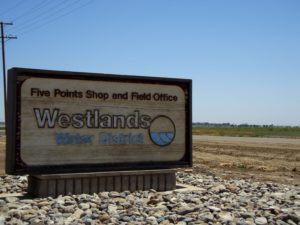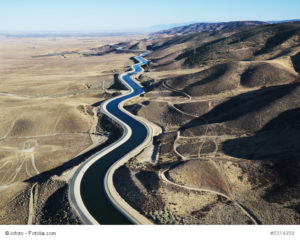An acre foot of water is the amount of water that it takes to occupy an acre of land at one foot deep. It’s generally assumed that a family of four in a water-rich region will use about one acre foot of water per year; two families can use the same amount if conserving water carefully.

Just the facts: Because it provides water to district farmers at well below the cost of delivery,* the Oakdale Irrigation District (OID) depends on water sales outside the district to balance its budget. OID’s best customer for water is the Westlands Water District.
Because water sales have clear impacts on the environment, they usually require an Environmental Impact Report (EIR). EIRs are expensive and often reveal a need for costly mitigation, so OID attempts to avoid an EIR whenever selling water.
The two chief ways OID attempts to avoid an EIR are by (1) claiming the water sale is for one time only and (2) by abandoning its water rights, then allowing the buyer to “pick up” the “abandoned” water for a price. Critics of OID’s abandonment of rights argue the practice could jeopardize the rights themselves and result in a loss of water in perpetuity.
In some cases, OID has referred to water abandonments and sales as “transfers.” The Bureau of Reclamation has rebuked OID for this practice and in 2016 wrote, “Reclamation also has concerns with the 2009, 2013, and 2015 water sales as transfers….These releases are not controlled under any water right once they are released from New Melones; therefore, they are not transfers.”
Over the last dozen or so years, farmers have planted over 40,000 acres of almond orchards in the foothills east and south of Oakdale. Because they are outside OID’s boundaries, virtually all the trees are dependent on groundwater.
After the orchards were planted, wells in areas nearby began going dry and the aquifer began to drop. Some of the foothills farmers have requested to be annexed into the OID, but OID has been reluctant to accommodate them.

Recent lawsuits against OID have focused on the district’s failure to account for the potential effects on groundwater when it sells water out of the district. California’s new groundwater regulations require water districts to work toward achieving groundwater sustainability. Thus far, courts have agreed that OID should take into account effects on groundwater before selling water by performing an EIR.
According to General Manager Steve Knell, recent estimates for groundwater pumping by OID farmers are at 20,000 acre feet per year. OID itself pumps approximately 8,000 acre feet per year. Wells are still going dry in and out of the district.
Westlands Water District is notorious for political machinations and spends millions of dollars for lobbyists in Washington D.C. and Sacramento. Although it’s the largest water district in the United States, Westlands is located in one of the most arid regions in California; the groundwater is bad and access to surface water is complicated by junior water rights—water rights for Westlands were gained long after such districts as OID had been granted their own “senior” water rights.
Over thirty years ago, irrigation water from Westlands Water District was implicated in severe bird deformities at Kesterson Wildlife Refuge due to dangerous levels of selenium that had accumulated in storage ponds for agricultural runoff. Over the years, various solutions have been proposed for the drainage problems. Most recently, a bill proposed by Congressman David Valadao would relieve Westlands of the $350 million it owes taxpayers for its share of the Central Valley Water Project in return for rectifying the drainage problems.
That’s right—Westlands Water District still has not paid its share for the Central Valley Water Project, which was completed in the 1970s. It’s managed to dodge its debt the same way it’s managed to acquire northern California water, by political power, especially as exercised by congressional representatives including David Valadao, Devin Nunes, Kevin McCarthy, and Jeff Denham, all of whom supported the 2014 California Drought Relief Act which would have assured continued shipments of northern California water south to Westlands even during drought years.

And even though farmers in the arid Westlands Water District and beyond have been able to somehow plant and maintain so-called “permanent” crops like almonds and pistachios, poor residents in small towns in the district have found their water rates skyrocketing even while their water has been judged unsafe to drink.
In El Porvenir, a small town in Fresno County, water rates are $110 a month for water residents can’t even use to cook with. That pencils out to $1320 an acre foot per family, assuming a family would use that much unsafe water.
Even an urban resident in water-rich Stanislaus County is likely to be paying $600 or $700 an acre foot of water or more. Meanwhile, multi-millionaire almond farmers often get water at below the cost of delivery.
And when OID sends water south, taxpayers and ratepayers foot the bill for infrastructure and pumping costs, evaporation losses, attorneys’ fees and other costs associated with selling water. When the water goes to Westlands, it goes to a district that owes taxpayers $350 million dollars and is poised to take over many of northern California’s priceless water rights with hardly a murmur of protest.
It’s just politics.
*The cost of delivery of water to OID farmers has been estimated at over $70 per acre foot. OID Tier 1 farmers pay $3.24 per acre foot of water, Tier 2 farmers pay $6.44, Tier 3 pay $8.55, and so on. The tiers are determined by water usage. There is also a $27.81 annual annexation fee per acre, payable in two installments, one due in December, one due in June. The shortfall between what the farmers pay and the actual cost of delivery of the water is theoretically made up for by selling power generated at the tri-dam complex and water sales outside the district.

My only comment is that Stanislaus County is not water rich. Taking all into account, including the large boor wells the speculators have drilled in the foothills to cash in on the high price of nut exports to other parts of the world , Hughson for example, ran out of water in their wells two years ago. Given the 40% the Ca Water Board wants of our three southern valley rivers, You can count us out. I see that you have addresses Denham’s take on water. I and several other people not of his party received a letter stating that that he offered two ammendments to the Departent of Interior appropriations bill.. ” The first ammendment put a stop to the state’s ability to flush water from Valley rivers by prohibiating the federal agencies from participating in the plan.” Is this BS? I haven’t found someone informed enough to answer my question. Would you?
June: I will be posting soon the exact wording of the rider to H.R. 6147 that Jeff Denham signed. The rider prohibits lawsuits against the Delta Tunnels. Denham also signed legislation prohibiting lawsuits against water projects in general.
Thank you, Eric. This is such a complicated issue!